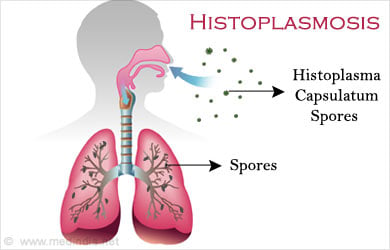- Histoplasmosis - (http://www.nlm.nih.gov/medlineplus/ency/article/001082.htm)
- About Histoplasmosis - (http://www.cdc.gov/fungal/diseases/histoplasmosis/)
- Eye Conditions and Diseases - (https://www.nei.nih.gov/health/histoplasmosis/histoplasmosis)
- Harrison's Principles of Internal Medicine, 18th Edition - Fauci et. Al, Chapter 199, Page 1640-1642
- Chu JH, Feudtner C, Heydon K, Walsh TJ, Zaoutis TE. Hospitalizations for endemic mycoses: a population-based national study. Clin Infect Dis. 2006 Mar 15;42(6):822-5.
What is Histoplasmosis?
Histoplasmosis is an infectious disease caused by a fungus, Histoplasma capsulatum. It is a disease that primarily affects the lungs, but other organs may be involved as well. It usually causes a mild illness that settles by itself. But sometimes, the disease may be prolonged or may be rapidly progressive, which typically happens in people with a weak immune system or those who have been exposed to a large amount of the fungus. Histoplasma capsulatum is found worldwide, particularly in North and Central America. In India, histoplasmosis is uncommon but is important for diagnosticians, as it may be easily misdiagnosed as Tuberculosis.

The disease is caused by inhalation of spores of the fungus. On very rare occasions, the disease may also be caused due to transplantation of organs from an infected donor or by injury to laboratory personnel dealing with the fungus.
The clinical picture of the disease varies depending on the extent of exposure to the fungus and the general immune status of the individual. In healthy people with good immunity, exposure to a small amount of the fungus may not result in symptomatic disease. But in people with low immunity or those who have been exposed to a large amount of the fungus, the disease may be severe.
Histoplasmosis is seen commonly among people who have HIV/AIDS is a common form of opportunistic Infections with approximately 30% of HIV/AIDS patients diagnosed with histoplasmosis dying from it.
The thread like branching fungus, after inhalation, infects a type of immune cell in the blood called the macrophages. The macrophages eat the fungus, but are unable to kill it because it changes to the yeast form. They then carry the fungus to the reticulo-endothelial system of the body, and get deposited in far off places like the liver and spleen. The immune reaction of the body starts after 10 days, and T-cells stimulate the macrophages to produce certain substances that kill the fungus.
How does the Histoplasma capsulatum fungus invade the body and Cause Histoplasmosis?
Histoplasmosis is caused by Histoplasma capsulatum, a dimorphic fungus. Dimorphic implies that the fungus exists in two forms: The mycelial vegetative form, which consists of many cells arranged in a thread like pattern and the yeast form, in which the fungus exists as a unicellular organism.
The fungus invades the body in the mycelia form, and when it is eaten by the immune cells, it changes to the yeast form, which can survive inside the immune cells.
H. capsulatum is commonly found in bird and bat droppings in the soil, which change the properties of the soil, thus favoring the growth of the fungus. Consequently, poultry farms and other animal farms are its densest reservoirs. The other place where it is liable to grow is in abandoned buildings and caves. It is likely to be inhaled when the environment is disturbed such as in destruction of abandoned lots, construction sites, and cave exploration (spelunking) hence it is also called spelunker’s lung or caver's disease.
Rarely, histoplasmosis can be acquired by transplantation of organs from infected hosts or by needle-stick injury to laboratory personnel.







